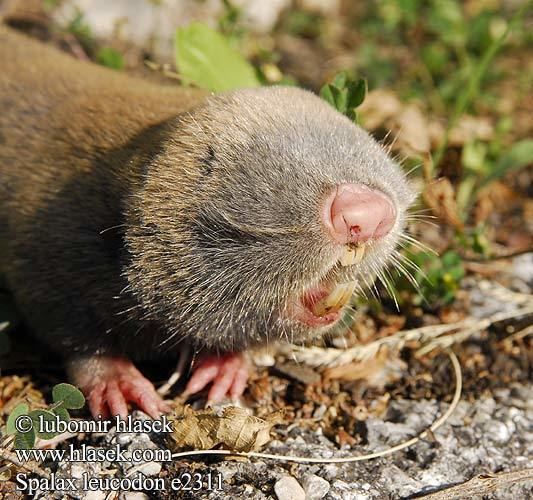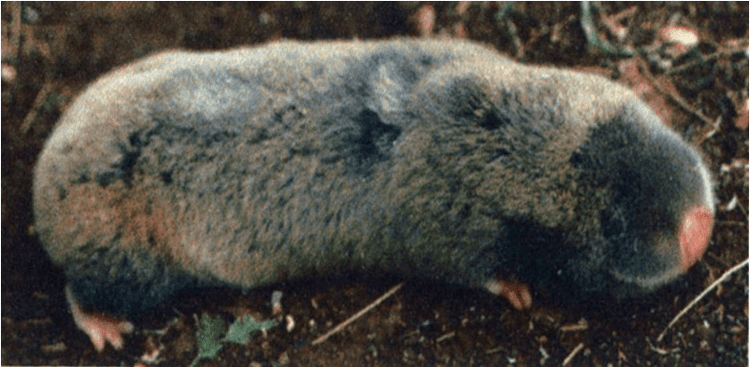Scientific name Spalax Higher classification Spalacinae Order Rodent | Subfamily SpalacinaeGray, 1821 Rank Genus | |
 | ||
Lower classifications Lesser mole‑rat, Middle East blind mole‑rat, Greater mole‑rat, Giant mole‑rat, Sandy mole‑rat Similar Greater mole rat, Lesser mole rat, Giant mole rat | ||
Slepo kuce spalax leucodon
The genus Spalax contains the blind, fossorial, or subterranean mole rats, which are one of several types of rodents that are called "mole rats". The hystricognath mole-rats of the family Bathyergidae are completely unrelated, but some other forms are also in the family Spalacidae. Zokors (subfamily Myospalacinae) and root rats and bamboo rats (subfamily Rhizomyinae) are spalacids sometimes referred to as mole rats. Blind mole rats are in the family Spalacidae, but are unique enough to be given a separate subfamily, Spalacinae. Alternate opinions on taxonomy consider the blind mole-rats to be the only members of the family Spalacidae and rank other spalacid subfamilies as full families. Other authors group all members of the superfamily Muroidea into a single family, Muridae. The Spalacinae contains two genera and eight species. Some authorities treat all species as belonging to a single genus, Spalax.
Contents

Spalax mole rats are truly blind. Their very small eyes are completely covered by a layer of skin. Unlike many other fossorial rodents, Spalax mole rats do not have enlarged front claws and do not appear to use their forearms as a primary digging tool. Digging is almost exclusively conducted using their powerful front teeth, which are separated from the rest of the mouth by a flap of skin. When a Spalax mole rat closes its mouth, its incisors are still on the outside. Blind mole rats may have evolved from spalacids that used their front limbs to dig, because their olecranon processes are relatively large relative to the rest of their arms. The olecranon process is a part of the ulna bone where muscles attach, and digging animals tend to have enlarged olecranon processes to provide a large surface for their large and powerful muscles to attach.

Because they are completely blind, blind mole rats have been important laboratory animals in tests on how eyes and eye proteins function. It should be emphasized that although Spalax has only atrophied subcutaneous eye and it is sightless, its circadian rhythm is kept. Few publications (Avivi et al) have proved that the circadian genes that control the biological clock are expressed in a similar manner as in sighted, aboveground mammals.

Resistance to cancer

Studies on the growth of fibroblasts in vitro of Spalax judaei and Spalax golani showed that the process of necrosis replaces the role of the systematic apoptosis normally used in most organisms. Low-oxygen conditions, such as those common in blind mole rats’ burrows, usually cause cells to undergo apoptosis. In adaptation to higher tendency of cell death, Avivi et al have shown that the blind mole rats evolved a mutation in the tumor suppressor protein p53 Avivi ert al, http://www.nature.com/onc/journal/v26/n17/pdf/1210045a.pdf (which is also used in humans) to prevent cells from undergoing apoptosis. Human cancer patients have similar mutations, and blind mole rats were thought to be more susceptible to cancer because their cells cannot undergo apoptosis. However, after a specific amount of time (within 3 days according to one study), the cells in blind mole rats release interferon-beta (which the immune system normally uses to counter viruses) in response to overproliferation of cells caused by the suppression of apoptosis. In this case, the interferon-beta triggers cells to undergo necrosis, and this mechanism also kills cancer cells in blind mole rats. Because of tumor suppression mechanisms such as this, blind mole rats and other spalacids are resistant to cancer. The involvement of interferon in the so called concertated cells death of Spalax cells via necrosis (see ref. 4) was highly criticized. Serious questions have been raised on the inconsistent methodolgy used that led to this speculation [see discussion at: https://bmcbiol.biomedcentral.com/articles/10.1186/1741-7007-11-91; Manov et al, BMC Biology , 2013]. Noteworthy, in this publication Manov et al, BMC Biology , 2013[8] interesting data on Spalax resistance to cancer have been documented:
See http://evolution.haifa.ac.il/index.php/29-people/personal-websites/77-personal-site-avivi
Classification
Subfamily Spalacinae
